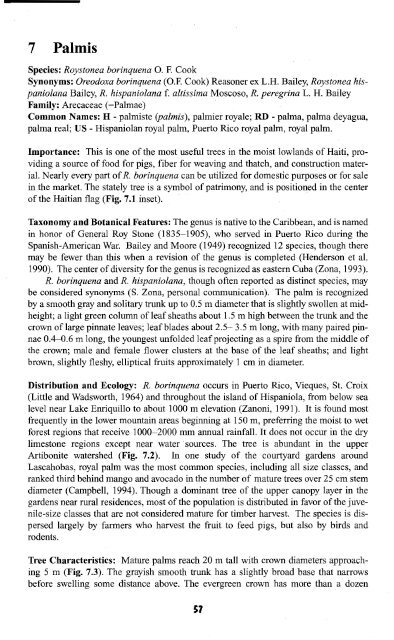Bwa-yo - Société Audubon Haiti
Bwa-yo - Société Audubon Haiti
Bwa-yo - Société Audubon Haiti
Create successful ePaper yourself
Turn your PDF publications into a flip-book with our unique Google optimized e-Paper software.
7 Palmis<br />
Species: Roystonea borinquena O. F. Cook<br />
Synonyms: Oreodoxa borinquena (O.F. Cook) Reasoner ex L.H. Bailey, Roystonea hispaniolana<br />
Bailey, R. hispaniolana f. altissima Moscoso, R. peregrina L. H. Bailey<br />
Family: Arecaceae (=Palmae)<br />
Common Names: H - palmiste (palmis), palmier royale; RD - palma, palma deyagua,<br />
palma real; US - Hispaniolan royal palm, Puerto· Rico royal palm, royal palm.<br />
Importance: This is one ofthe most useful trees in the moist lowlands of <strong>Haiti</strong>, providing<br />
a source of food for pigs, fiber for weaving and thatch, and construction material.<br />
Nearly every part ofR. borinquena can be utilized for domestic purposes or for sale<br />
in the market. The stately tree is a symbol ofpatrimony, and is positioned in the center<br />
of the <strong>Haiti</strong>an flag (Fig. 7.1 inset).<br />
Taxonomy and Botanical Features: The genus is native to the Caribbean, and is named<br />
in honor of General Roy Stone (1835-1905), who served in Puerto Rico during the<br />
Spanish-American War. Bailey and Moore (1949) recognized 12 species, though there<br />
may be fewer than this when a revision of the genus is completed (Henderson et al.<br />
1990). The center ofdiversity for the genus is recognized as eastern Cuba (Zona, 1993).<br />
R. borinquena and R. hispaniolana, though often reported as distinct species, may<br />
be considered synonyms (S. Zona, personal communication). The palm is recognized<br />
by a smoothgray and solitary trunk up to 0.5 m diameter that is slightly swollen at midheight;<br />
a light green column ofleaf sheaths about 1.5 m high between the trunk and the<br />
crown of large pinnate leaves; leafblades about 2.5- 3.5 m long, with many paired pinnae<br />
0.4-0.6 m long, the <strong>yo</strong>ungest unfolded leafprojecting as a spire from the middle of<br />
the crown; male and female flower clusters at the base of the leaf sheaths; and light<br />
brown, slightly fleshy, elliptical fruits approximately 1 cm in diameter.<br />
Distribution and Ecology: R. borinquena occurs in Puerto Rico, Vieques, St. Croix<br />
(Little and Wadsworth, 1964) and throughout the island of Hispaniola, from below sea<br />
level near Lake Enriquillo to about 1000 m elevation (Zanoni, 1991). It is found most<br />
frequently in the lower mountain areas beginning at 150 m, preferring the moist to wet<br />
forest regions that receive 1000-2000 mm annual rainfall. It does not occur in the dry<br />
limestone regions except near water .sources. The tree is abundant in the upper<br />
Artibonite watershed (Fig. 7.2). In one study of the courtyard gardens around<br />
Lascahobas, royal palm was the most common species, including all size classes, and<br />
ranked third behind mango and avocado in the number of mature trees over 25 cm stem<br />
diameter (Campbell, 1994). Though a dominant tree of the upper canopy layer in the<br />
gardens near rural residences, most ofthe population is distributed in favor ofthe juvenile-size<br />
classes that are not considered mature for timber harvest. The species is dispersed<br />
largely by farmers who harvest the fruit to feed pigs, but also by· birds and<br />
rodents.<br />
Tree Characteristics: Mature palms reach 20 m tall with crown diameters approaching<br />
5 ill (Fig. 7.3). The grayish smooth trunk has a slightly broad base that narrows<br />
before swelling some distance above. The evergreen crown has more than a dozen<br />
S7



